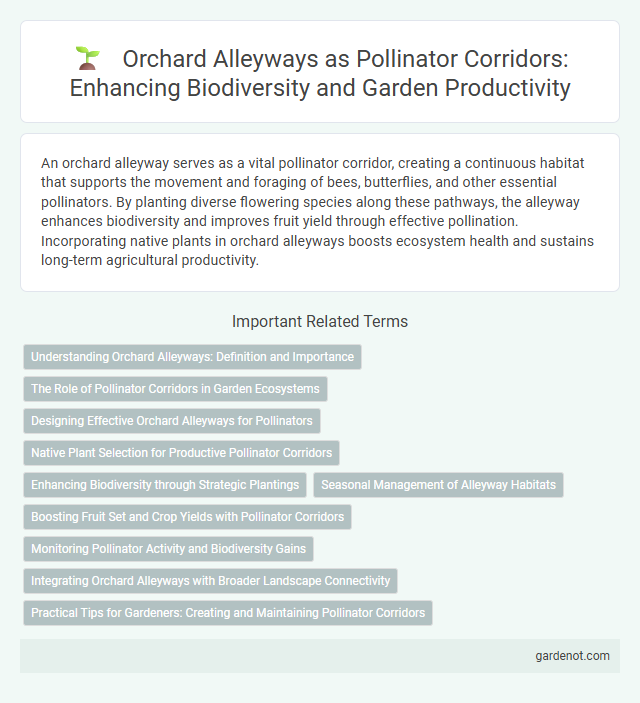An orchard alleyway serves as a vital pollinator corridor, creating a continuous habitat that supports the movement and foraging of bees, butterflies, and other essential pollinators. By planting diverse flowering species along these pathways, the alleyway enhances biodiversity and improves fruit yield through effective pollination. Incorporating native plants in orchard alleyways boosts ecosystem health and sustains long-term agricultural productivity.
Understanding Orchard Alleyways: Definition and Importance
Orchard alleyways are strategically spaced rows between fruit trees designed to promote airflow, sunlight penetration, and easy access for maintenance and pollinators. These corridors serve as essential habitats for bees and other pollinators, enhancing pollination efficiency and fruit yield. Optimizing orchard alleyway design supports biodiversity and sustainable agricultural practices by creating a pollinator-friendly environment within commercial and home orchards.
The Role of Pollinator Corridors in Garden Ecosystems
Orchard alleyways serve as vital pollinator corridors, enhancing biodiversity and promoting the health of garden ecosystems by facilitating the movement of bees, butterflies, and other pollinators. These linear habitats support increased fruit set and yield in adjacent orchard trees by ensuring efficient cross-pollination. Establishing native flowering plants along alleyways strengthens ecological connectivity and resilience against environmental stressors.
Designing Effective Orchard Alleyways for Pollinators
Designing effective orchard alleyways for pollinators involves selecting a diverse mix of native flowering plants that bloom sequentially to provide continuous forage throughout the growing season. Incorporating wildflower strips, flowering shrubs, and habitat features such as nesting sites encourages pollinator diversity and abundance, enhancing fruit set and yield. Properly spaced alleys improve airflow and sunlight penetration while supporting pollinator movement across the orchard landscape.
Native Plant Selection for Productive Pollinator Corridors
Orchard alleyways thrive when native plant species such as goldenrod, milkweed, and wild bergamot are strategically selected to enhance pollinator corridors. These native plants provide essential nectar and pollen, supporting diverse pollinator populations including bees, butterflies, and hummingbirds. Integrating native flora in orchard alleys increases pollination efficiency, leading to improved fruit yield and ecosystem health.
Enhancing Biodiversity through Strategic Plantings
Orchard alleyways serve as vital pollinator corridors by integrating nectar-rich flowering plants that attract diverse pollinator species such as bees, butterflies, and hoverflies. Strategic plantings in orchard alleyways increase habitat connectivity, supporting pollinator movement and enhancing genetic diversity within surrounding ecosystems. This approach not only boosts crop pollination efficiency but also contributes to overall biodiversity conservation in agricultural landscapes.
Seasonal Management of Alleyway Habitats
Seasonal management of orchard alleyways enhances pollinator habitats by incorporating diverse flowering plants that bloom throughout the growing season, ensuring continuous forage availability. Implementing targeted mowing schedules preserves native wildflowers and maintains habitat structure critical for pollinator nesting and shelter. Strategic timing of pesticide applications minimizes harm to beneficial insects, supporting robust pollinator populations vital for orchard productivity.
Boosting Fruit Set and Crop Yields with Pollinator Corridors
Orchard alleyways integrated with pollinator corridors significantly enhance fruit set by increasing pollinator visitation rates and diversity. These corridors provide essential habitat and forage resources for bees and other pollinators, leading to improved crop yields and fruit quality. Implementing pollinator-friendly plants along orchard alleyways supports sustainable agricultural productivity and biodiversity conservation.
Monitoring Pollinator Activity and Biodiversity Gains
Orchard alleyways serve as vital habitats for monitoring pollinator activity, allowing researchers to track species diversity and population dynamics effectively. Regular surveys within these corridors reveal significant biodiversity gains, highlighting increased presence of native bees, butterflies, and other pollinators critical to orchard health. Data collected supports adaptive management strategies that enhance pollination services and promote ecosystem resilience.
Integrating Orchard Alleyways with Broader Landscape Connectivity
Integrating orchard alleyways into broader landscape connectivity enhances pollinator movement by providing continuous foraging habitats and safe pathways across fragmented ecosystems. These alleyways serve as vital ecological corridors linking diverse plant communities, thus supporting pollinator biodiversity and genetic exchange. Incorporating native flowering species and minimizing pesticide use within orchard alleyways further strengthens their function in sustaining healthy pollinator populations across agricultural and natural landscapes.
Practical Tips for Gardeners: Creating and Maintaining Pollinator Corridors
Gardeners can establish pollinator corridors in orchard alleyways by planting diverse native flowering plants that bloom sequentially throughout the growing season, ensuring continuous nectar and pollen sources. Incorporating flowering hedgerows and cover crops like clover or buckwheat enhances habitat connectivity and supports vital pollinator species such as bees, butterflies, and hoverflies. Regularly avoiding pesticides and maintaining structural diversity in vegetation promotes healthy pollinator populations, maximizing orchard productivity and ecosystem resilience.
Orchard alleyway Infographic

 gardenot.com
gardenot.com